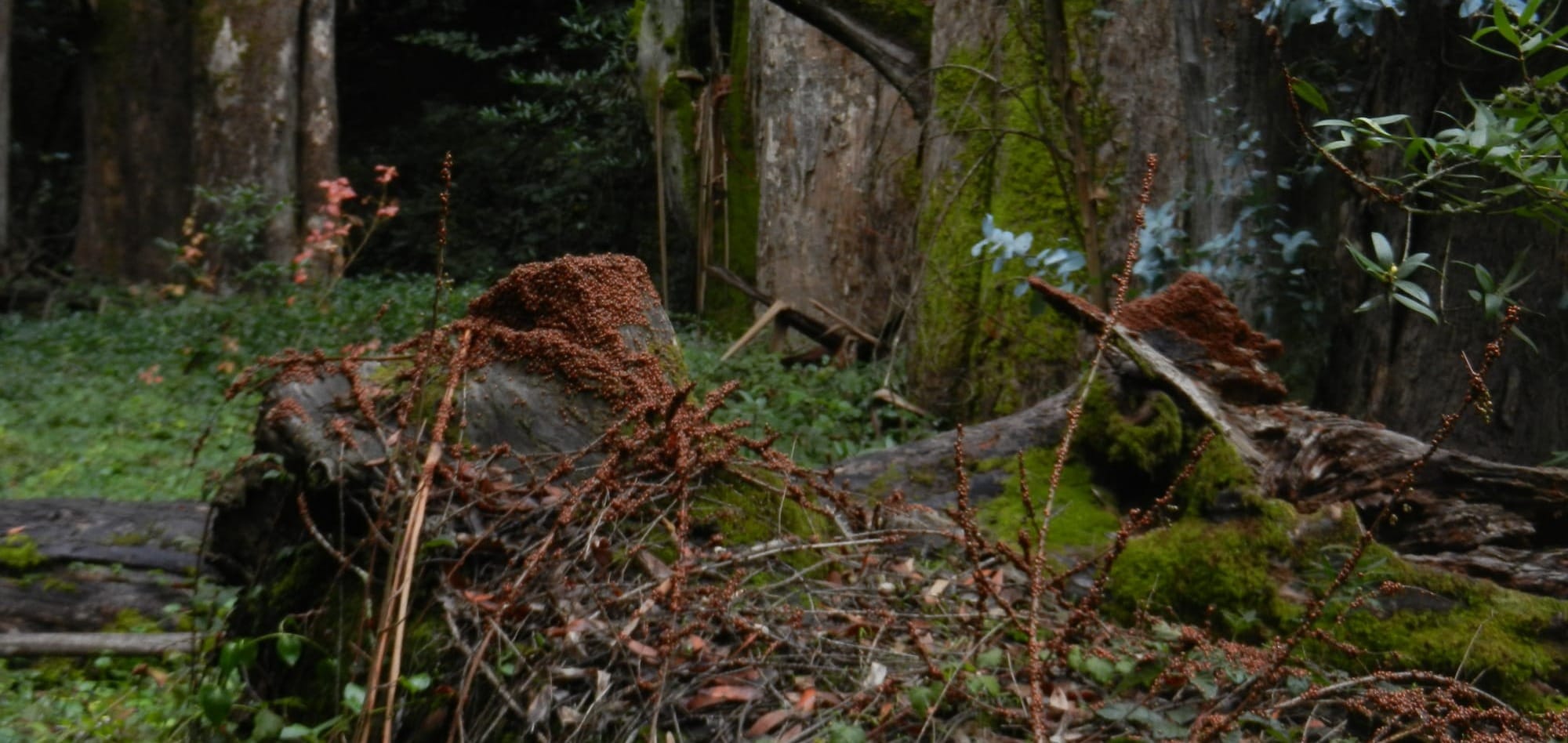The wind shook the trees as I walked down Stream Trail alongside many other hikers. I can’t speak for them, but I was there for a singular purpose — searching for many small things in the woods. As I headed deeper down the fire road, passing small outcroppings of bay trees and tan oak, the soft movements of drizzle and wind filled the air. At first, walking in and out of patches of trees, I wondered if I was going to get soaked — I didn’t bring a rain coat. Maybe Fall was here. By the time I arrived underneath the second growth redwoods, deeper in the valley of the trail, the redwood needles had slowed the rain’s path. I stopped along the trail and listened. Nothing. Just the air, and the heaving wings of a raven up above me. Walking a little bit further, I found what I had walked down into this valley to see — the wintering ground of the ladybugs of Oakland.
Since as far back as anyone knows, this area has been the wintering home of the native convergent ladybug (Hippodamia convergens), a small, red, multi-dotted ladybug whose black head has two distinct lines pointing to their eyes. The area they make home is a small outcropping just past the redwoods and one of the most consistent places in the Bay Area to see ladybugs. There are tall, non-native eucalyptus at the edge of the stream, but at the fence beside the trail, it is almost entirely native blackberry, having completely taken over the area.
If you’re idly walking by, maybe chatting with a friend or just heavily lost in thought (like I was before I first saw them), you might not notice the critters. Swarming, or more accurately cuddling, these ladybugs, for the months of October through February, make the redwoods their home. Perhaps using pheromones left from the previous seasons, many of the bugs return here to this native wintering ground. Scientists, actually, don’t know much about the wintering habits of ladybugs, save the fact that gathering in these large groups is likely a way to survive the colder months of winter. Cold blooded ladybugs typically live for a full calendar year in the wild, though some species are estimated to live on average for three years. Convergent ladybugs, one of the 175 species native to California, and the dozens that are native to the Bay Area itself, can live, tops, up to two years. Because of these somewhat long lives for a creature as small as they are, keeping warm in the winter months is paramount.

But why this area? As someone who knows severely less than any aspiring entomologist, my best guess would be that they choose this location because there is good leaf coverage to hide from the rains while being deep enough in a valley to not be too impacted by the winds during storms.
As other hikers asked themselves that same question, I watched closely as the ladybugs climbed frantically over each other, like people rushing to find the best seat in the theater, finding their best seat for winter.
I imagine it must be cozy, returning to this place, seeing the little critters you grew up with, just before the twilight of your time alive, remarking on the adventures of your lives and the prevailing winds that brought them home. But I doubt they know each other like that, or have strong vocabularies. But you can’t exactly rule it out, right? I know I shouldn’t anthropomorphize them, but watching as they shrug one another off their backs, taking moments to wipe their antennae, I can’t help but see their characters, each a specific individual gathered together to warm the collective through winter.
Seeing them here wasn’t just some welcome reminder to get more ladybug-like for the winter months—to stay inside, to get cozy as cool air and the next cycle of atmospheric rivers dump across the Bay, flooding the corners and streets, making mudslides of homes on the hills—they are also a remarkable piece of consistency in these hills of Oakland. For unknown generations these little creatures have made this little grove their winter home.

Usually, when the Fall air shifts between hot and cold, I start to worry. I worry over the timing of flower blooms, the falling of the leaves, the currents of the cold water in the oceans. Will they grow too soon? Will they fall too early? Will they stop churning? As I walked down Stream Trail from Skyline Boulevard this past Sunday, on my way to see the ladybugs, I worried about this. Honestly, I worry about it also while I’m in my car, burning fuel, or surfing, or writing, or walking, or working. That fear takes constant refuge behind my thoughts. The days on average are getting hotter each year, so I look for the smaller things, sometimes only half a centimeter long, as a reminder that not everything is changing. Some things in the world still feel the coming rains of December and move with the tilting of the earth.
As the climate is getting more and more fucked, as the country backslides, as any real change for people or the planet feels all the more challenging, there are these little bugs, all working together to stay warm. The return of ladybugs to their wintering ground persists in their yearly rhythms despite the force of the world bearing down on them–a force that threatens those rhythms every day.
